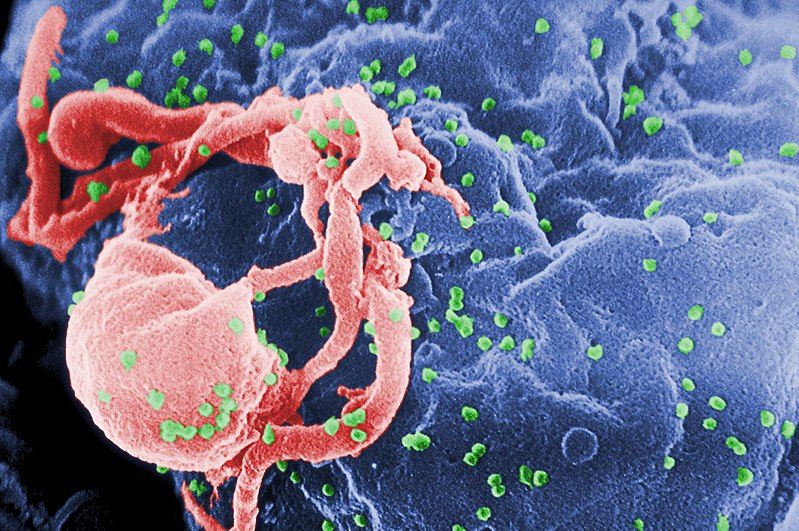

| Visitors Now: | |
| Total Visits: | |
| Total Stories: |

| Story Views | |
| Now: | |
| Last Hour: | |
| Last 24 Hours: | |
| Total: | |
Natural Compound Eliminates HIV In Infected Cells Says Scripps Researcher
Scanning electron micrograph of HIV-1 (in green) budding from cultured lymphocyte. Multiple round bumps on cell surface represent sites of assembly and budding of virions.

The HIV/AIDS pandemic continues to affect 34 million individuals worldwide, including more than 3 million children, according to the World Health Organization. Current treatment involves the use of several antiretroviral drugs, termed Highly Active Antiretroviral Therapy (HAART), which can extend the life expectancy of HIV-positive individuals and decrease viral load without, however, eradicating the virus.
“We know that there are reservoirs of HIV that aren’t being eliminated by current treatment and that keep replenishing the infection,” said Susana Valente, a Scripps Research biologist who led the study. “Viral production from these cellular reservoirs that harbor an integrated viral genome is not affected by current antiretroviral drugs, which only stop novel rounds of infection. The compound in the current study virtually eliminates all viral replication from already-infected cells where HIV hides.”
Scripps Research Institute
The new study, published in the July 20, 2012 issue of the journal Cell Host and Microbe, focused on a medically promising compound known as Cortistatin A. This natural product was isolated in 2006 from a marine sponge, Corticium simplex, discovered more than 100 years ago. In 2008, Scripps Research chemist Phil Baran and his team won the global race to synthesize the compound, presenting an efficient and economical method.
In the new study, Valente and her colleagues collaborated with the Baran lab, using a synthetic version of the compound, didehydro-Cortistatin A, to study the compound’s effect on two strains of HIV. The strains were HIV-1, the most common form of the virus, and HIV-2, which is concentrated in West Africa and some parts of Europe.
The results showed that the compound reduced viral production by 99.7 percent from primary CD4+T cells (a type of immune cell) isolated from patients without levels of the virus in their bloodstream and who had been under HAART treatment for a long period of time. When the compound was added to other antiviral treatments, it further reduced by 20 percent viral replication from CD4+T cells isolated from patients with detectable amounts of virus in their bloodstreams.
The inhibitor works by binding tightly to the viral protein known as Tat, a potent activator of HIV gene expression, effectively preventing the virus from replicating even at miniscule concentrations—making it the most potent anti-Tat inhibitor described to date, Valente said.
Another interesting feature of this compound is that withdrawal of the drug from cell culture does not result in virus rebound, which is normally observed with other antiretrovirals.
While most antiretroviral compounds block only new infections, didehydro-Cortistatin A reduces viral replication from already-infected cells, potentially limiting cell-to-cell transmission.
The new inhibitor already has a drug-like structure, is effective at very low concentrations, and has no toxicity associated with it, at least at the cellular level, the study noted.
Contacts and sources:
The Scripps Research Institute Florida
Citation: Cell Host & Microbe 12, 97–108, July 19, 2012;
Guillaume Mousseau,1; Mark A. Clementz,1; Wendy N. Bakeman,1; Nisha Nagarsheth,1; Michael Cameron, 2; Jun Shi, 3;
Phil Baran, 3; Re´ mi Fromentin, 4; Nicolas Chomont, 4; and Susana T. Valente 1,*
1 Department of Infectology
2 Department of Molecular Therapeutics and Translational Research Institute
The Scripps Research Institute, Scripps Florida, 130 Scripps Way, Jupiter, FL 33458, USA
3 Department of Chemistry, The Scripps Research Institute, 10550 North Torrey Pines Road, La Jolla, CA 92037, USA
4 Vaccine and Gene Therapy Institute, 9801 SW Discovery Way, Port St. Lucie, FL 34987, USA
* Correspondence: [email protected]
Read more at Nano Patents and Innovations
Source:


